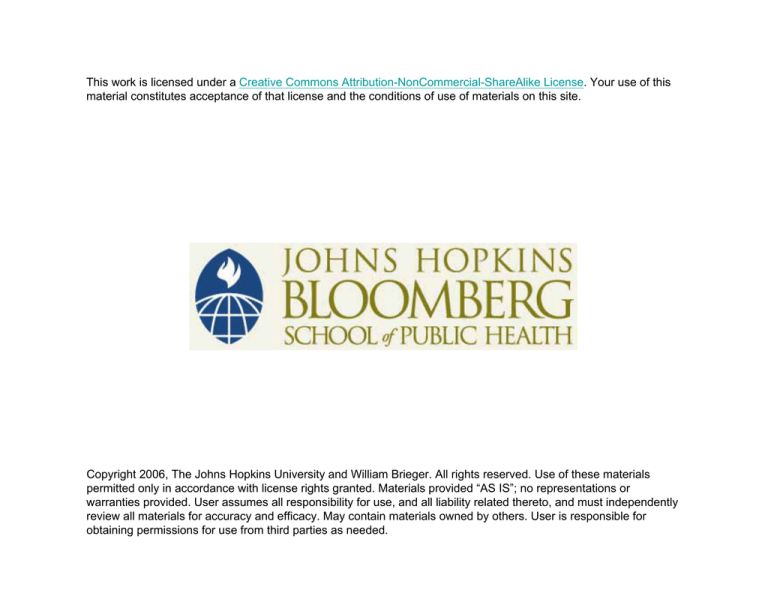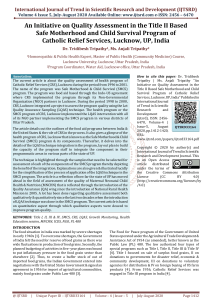
This work is licensed under a Creative Commons Attribution-NonCommercial-ShareAlike License. Your use of this
material constitutes acceptance of that license and the conditions of use of materials on this site.
Copyright 2006, The Johns Hopkins University and William Brieger. All rights reserved. Use of these materials
permitted only in accordance with license rights granted. Materials provided “AS IS”; no representations or
warranties provided. User assumes all responsibility for use, and all liability related thereto, and must independently
review all materials for accuracy and efficacy. May contain materials owned by others. User is responsible for
obtaining permissions for use from third parties as needed.
Community Participation
William R. Brieger, MPH, CHES, DrPh
Johns Hopkins University
1
Section A
What Is Participation?
2
Community participation: The centerpiece of PHC
3
From Alma Ata
Ù Primary health care is essential health
care based on practical, scientifically
sound, and socially acceptable
methods and technology
Ù Made universally accessible to
individuals and families in the
community
Ù Through their full participation, and
Continued
4
From Alma Ata
Ù At a cost that the community and
country can afford to maintain at every
stage of their development
Ù In the spirit of self-reliance and selfdetermination
5
PHC Requires and Promotes
Ù Maximum community and individual
self-reliance
Ù Participation in the planning,
organization, operation, and control of
primary health care
Ù Making fullest use of local, national,
and other available resources
Continued
6
PHC Requires and Promotes
Ù To this end, develop through
appropriate education the ability of
communities to participate
7
What Constitutes Participation
Ù Active involvement of the local
population in the decision making and
implementation of development
projects
Continued
8
What Constitutes Participation
Ù Role of the community
– Formulating a health program
– Enabling its residents to
understand and make informed
choices
– Reconciling outside objectives with
community priorities
Continued
9
What Constitutes Participation
Ù The community both determines
collective needs and priorities, and
assumes responsibility for these
decisions
10
Why Participation?
Assumptions about Participation Effects
Ù Increases program acceptance,
ownership
Ù Ensures programs meet local needs
Ù May reduce costs using local resources
Ù Uses local/familiar organizations,
problem solving mechanisms—more
efficient
Ù Some examples follow
11
Promoting Filters by VHWs
Product, price, place and promotion organized by VHWs
12
Participation Effects
Guinea Worm Filter Sales Where VHW Takes Part
45
40
35
30
25
20
15
10
5
0
VHW sold
VHW advised
No VHW
13
Community Involvement in
Water Supply Improvements
Ù Raising money
Ù Helping dig
Ù Dedicating
the well
Ù Supervising
use and
maintenance
Community involvement
14
Community involvement
15
Participation in
Water Supply Project
Multiplier Effect on Immunization Participation
60
50
40
Indonesia
Togo
30
20
10
0
participatory
non-part
no project
16
Community-Managed
Essential Drugs
VHWs Buy and Maintain Stock
70
60
50
Community
Controlled
LGA Controlled
40
30
20
10
0
% buy stock
mean times buy
17
Community Meetings
to Discuss CDTI
Ù Community organization for program
specific goals
Ù Principles of active participation are
maintained
Ù Local decision making and
commitment to decisions facilitated
18
Community meeting
19
CDTI vs Program-Directed
Effect on Ivermectin Coverage (TDR/APOC)
70
60
50
40
CDTI
Program
30
20
10
0
Kaduna
Enugu
Yola
Mali
20
WARMI Means Woman
Save the Children
Ù Community
organization
Ù Community groups
determine priorities
Ù Plan projects
Ù Acquire resources
Ù Administer and
coordinate
Source: Save the Children
21
WARMI: The Community
Planning Cycle
Ù Identification and prioritization of
problems
Ù Planning together
Ù Implementation by community
members
Ù Evaluation by community members
22
Community Problem Solving
Source: Save the Children
23
Participatory Approach
to Improve MCH
In Bolivia, Women’s Groups Plan Their Own Program
120
100
80
60
40
20
0
Perinat
Mort
TT
Contra
Cover
Use
Follow-up
ANC
Visit
Trained
Attend
Initiate
BF
Baseline
24
Section B
Levels of Involvement
25
Levels of Involvement
Involvement Vs. Participation
Ù
Ù
Ù
Ù
Ù
Acceptance—Utilize
Mobilization—Contribute
Participation—Implement
Involvement—Plan
Control/ownership—Community
directs; toward increasing community
ownership
26
Am o u n t o f in volvem en t
Levels of Participation
120
100
80
60
40
20
0
accept
mobiliz
particip
involve
control
Level of Participation
27
Acceptance Can Be Likened
to Passive Participation
Ù Passive participation includes
complete cooperation on the part of
the community in the implementation
of the program to achieve the
objectives and targets set for the
program
– Does not ask of the community
contributions in terms of resources,
cash, or labor
Continued
28
Acceptance Can Be Likened
to Passive Participation
Ù Education aims at motivation for
completion of the tasks determined by
the agency
29
What Is Mobilization?
Ù A broad-scale movement to engage
large numbers of people in action for
achieving a specific development goal
through self-reliant effort
Ù A process of bringing together intersectoral social allies to raise awareness
and demand for a particular
development program, to assist in the
delivery of resources and services
Continued
30
What Is Mobilization?
Ù This approach, combined with
community participation, has also
proved to be a very important tool in
helping to create a supportive
environment for sustainable behavior
change
31
Participation or Taking Part
In Something Designed/Planned by Others
Ù Active participation—Inputs are
provided by both the government and
local population
Ù The importance of identifying
appropriate community members to
take a lead in community-based
activities
Continued
32
Participation or Taking Part
In Something Designed/Planned by Others
Ù Although based in the community and
with inputs from the community—
including even leadership and
resources—participation may not be of
the community
33
Involvement Addresses
Ownership
Ù The ideas may still come from outside
but the community internalizes them
Ù Depends on the voluntary contribution
(e.g., of labor, funds, and resources)
Ù Community ownership of the program
or intervention is a key to its
sustainability
Continued
34
Involvement Addresses
Ownership
Ù Only when the intervention is seen as
belonging to them can they be
expected to take responsibility for
maintaining the activities and
improving upon them
35
Community Control
Ù Change is directed by the community
Ù Community identifies the problem
Ù Makes all key decisions on goals and
means
Ù The organization is willing to help
[facilitate] the community at each step
to accomplish its goals
Ù The approach to change is
normative/re-educative
36
Community control comes
when members get
together and make
decisions
37
Facilitation vs Participation
Ù Facilitation is open-ended
– “Do you have health problems?
What do you think causes them?
What do you want to do about
them? How can we help?”
– Issues perceived by the community
to belong to themselves—more
likely to be sustainable
Continued
38
Facilitation vs Participation
Ù Participation is program-specific
– “We want to eliminate
onchocerciasis. We need your
help. This is what you need to do.
Will you help?”
– Issue perceived by the community
to belong to the health workers—
remains the ultimate responsibility
of the health workers
39
How to Facilitate?
Ù
Ù
Ù
Ù
Ù
How to promote community control?
Can we listen?
Can we learn from local knowledge?
Can we adopt new roles?
Can we allow and enable front-line
health workers themselves to be
involved in programming?
40
Are Health Workers Ready for
New Roles and Relationships?
Ù
Ù
Ù
Ù
Ù
Ù
Ù
Facilitating community involvement
Listening to community concerns
Respecting community views
Working together as partners
Encouraging community decisions
Standing by community decisions
Helping communities link with
resources
41






